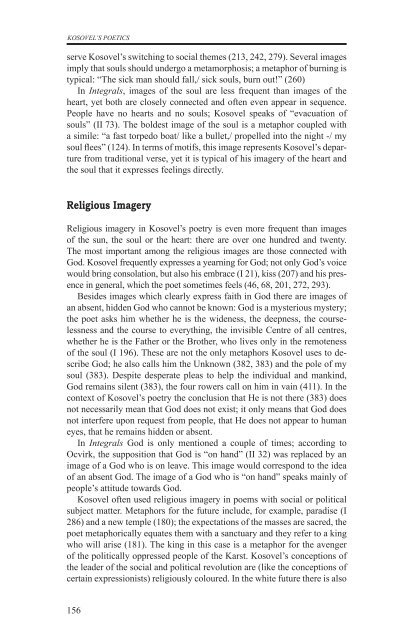razprave (pdf) - Društvo za primerjalno književnost - ZRC SAZU
razprave (pdf) - Društvo za primerjalno književnost - ZRC SAZU
razprave (pdf) - Društvo za primerjalno književnost - ZRC SAZU
- No tags were found...
Create successful ePaper yourself
Turn your PDF publications into a flip-book with our unique Google optimized e-Paper software.
KOSOVEL’s poeticsserve Kosovel’s switching to social themes (213, 242, 279). Several imagesimply that souls should undergo a metamorphosis; a metaphor of burning istypical: “The sick man should fall,/ sick souls, burn out!” (260)In Integrals, images of the soul are less frequent than images of theheart, yet both are closely connected and often even appear in sequence.People have no hearts and no souls; Kosovel speaks of “evacuation ofsouls” (II 73). The boldest image of the soul is a metaphor coupled witha simile: “a fast torpedo boat/ like a bullet,/ propelled into the night -/ mysoul flees” (124). In terms of motifs, this image represents Kosovel’s departurefrom traditional verse, yet it is typical of his imagery of the heart andthe soul that it expresses feelings directly.Religious ImageryReligious imagery in Kosovel’s poetry is even more frequent than imagesof the sun, the soul or the heart: there are over one hundred and twenty.The most important among the religious images are those connected withGod. Kosovel frequently expresses a yearning for God; not only God’s voicewould bring consolation, but also his embrace (I 21), kiss (207) and his presencein general, which the poet sometimes feels (46, 68, 201, 272, 293).Besides images which clearly express faith in God there are images ofan absent, hidden God who cannot be known: God is a mysterious mystery;the poet asks him whether he is the wideness, the deepness, the courselessnessand the course to everything, the invisible Centre of all centres,whether he is the Father or the Brother, who lives only in the remotenessof the soul (I 196). These are not the only metaphors Kosovel uses to describeGod; he also calls him the Unknown (382, 383) and the pole of mysoul (383). Despite desperate pleas to help the individual and mankind,God remains silent (383), the four rowers call on him in vain (411). In thecontext of Kosovel’s poetry the conclusion that He is not there (383) doesnot necessarily mean that God does not exist; it only means that God doesnot interfere upon request from people, that He does not appear to humaneyes, that he remains hidden or absent.In Integrals God is only mentioned a couple of times; according toOcvirk, the supposition that God is “on hand” (II 32) was replaced by animage of a God who is on leave. This image would correspond to the ideaof an absent God. The image of a God who is “on hand” speaks mainly ofpeople’s attitude towards God.Kosovel often used religious imagery in poems with social or politicalsubject matter. Metaphors for the future include, for example, paradise (I286) and a new temple (180); the expectations of the masses are sacred, thepoet metaphorically equates them with a sanctuary and they refer to a kingwho will arise (181). The king in this case is a metaphor for the avengerof the politically oppressed people of the Karst. Kosovel’s conceptions ofthe leader of the social and political revolution are (like the conceptions ofcertain expressionists) religiously coloured. In the white future there is also156
















